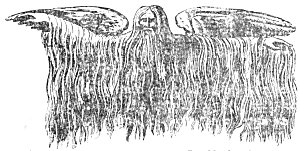As Odin founded his Mysteries in Scandinavia, and Quexalcoatl in Mexico, so Moses, laboring with the then nomadic people of Israel’s twelve tribes, established in the midst of them his secret and symbolic school, which has came to be known as The Tabernacle Mysteries. The Tabernacle of: the Jews was merely a temple patterned after the temples of Egypt, and transportable to meet the needs of that roving disposition which the Israelites were famous. Every part of the Tabernacle and the enclosure which surrounded it was symbolic of some great natural or philosophic truth. To the ignorant it was but a place to which to bring offerings and in which to make sacrifice; to the wise it was a temple of learning, sacred to the Universal Spirit of Wisdom.
While the greatest, minds of the Jewish and Christian worlds have realized that the Bible is a book of allegories, few seem to have taken the trouble to investigate its symbols and parables. When Moses instituted his Mysteries, he is said to have given to a chosen few initiates certain oral teachings which could never be written but were to be preserved from one generation to the next by word-of-mouth transmission. Those instructions were in the form of philosophical keys, by means of which the allegories were made to reveal their hidden significance. These mystic keys to their sacred writings were called by the Jews the Qabbalah (Cabala, Kaballah).
The modern world seems to have forgotten the existence of those unwritten teachings which explained satisfactorily the apparent contradictions of the written Scriptures, nor does it remember that the pagans appointed their two-faced Janus as custodian of the key to the Temple of Wisdom. Janus has been metamorphosed into St. Peter, so often symbolized as holding in his hand the key to the gate of heaven. The gold and silver keys of “God’s Vicar on Earth,” the Pope, symbolizes this “secret doctrine” which, when properly understood, unlocks the treasure chest of the Christian and Jewish Qabbalah.
The temples of Egyptian mysticism (from which the Tabernacle was copied) were–according to their own priests–miniature representations of the universe. The solar system was always regarded as a great temple of initiation, which candidates entered through the gates of birth; after threading the tortuous passageways of earthly existence, they finally approached the veil of the Great Mystery–Death–through whose gate they vanished back into the invisible world. Socrates subtly reminded his disciples that Death was, in reality, the great initiation, for his last words were: “Crito, I owe a cock to Asclepius; will you remember to pay the debt?” (As the rooster was sacred to the gods and the sacrifice of this bird accompanied a candidate’s introduction into the Mysteries, Socrates implied that he was about to take his great initiation.)
Life is the great mystery, and only those who pass successfully through its tests and trials, interpreting them aright and extracting the essence of experience therefrom, achieve true understanding. Thus, the temples were built in the form of the world and their rituals were based upon life and its multitudinous problems. Nor only was the Tabernacle itself patterned according to Egyptian mysticism; its utensils were also of ancient and accepted form. The Ark
THE ANCIENT OF DAYS.
From Montfaucon’s Antiquities. It is in this form that Jehovah is generally pictured by the Qabbalists. The drawing is intended to represent the Demiurgus of the Greeks and Gnostics, called by the Greeks “Zeus,” the Immortal Mortal, and by the Hebrews “IHVH.”
p. 134
of the Covenant itself was an adaptation of the Egyptian Ark, even to the kneeling figures upon its lid. Bas-reliefs on the Temple of Philæ show Egyptian priests carrying their Ark–which closely resembled the Ark of the Jews–upon their shoulders by means of staves like those described in Exodus.
The following description of the Tabernacle and its priests is based upon the account of its construction and ceremonies recorded by Josephus in the Third Book of his Antiquities of the Jews. The Bible references are from a “Breeches” Bible (famous for its rendering of the seventh verse of the third chapter of Genesis), printed in London in 1599, and the quotations are reproduced in their original spelling and punctuation.
THE BUILDING OF THE TABERNACLE
Moses, speaking for Jehovah, the God of Israel, appointed two architects to superintend the building of the Tabernacle. They were Besaleel, the son of Uri, of the tribe of Judah, and Aholiab, the son of Ahisamach, of the tribe of Dan. Their popularity was so great that they were also the unanimous choice of the people. When Jacob upon his deathbed blessed his sons (see Genesis xlix), he assigned to each a symbol. The symbol of Judah was a lion; that of Dan a serpent or a bird (possibly an eagle). The lion and the eagle are two of the four beasts of the Cherubim (the fixed signs of the zodiac); and the Rosicrucian alchemists maintained that the mysterious Stone of the Wise (the Soul) was compounded with the aid of the Blood of the Red Lion and the Gluten of the White Eagle. It seems probable that there is a hidden mystic relationship between fire (the Red Lion), water (the White Eagle), as they were used in occult chemistry, and the representatives of these two tribes whose symbols were identical with these alchemical elements.

Moe is the founder of GnosticWarrior.com. He is a father, husband, author, martial arts black belt, and an expert in Gnosticism, the occult, and esotericism.





